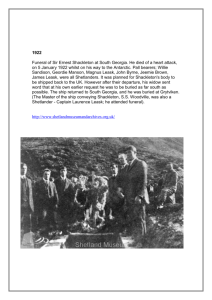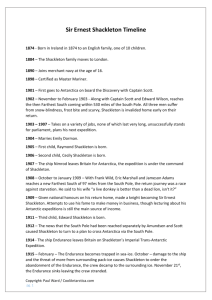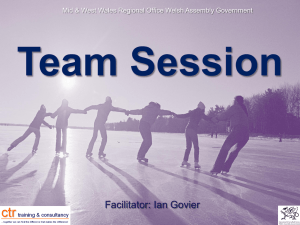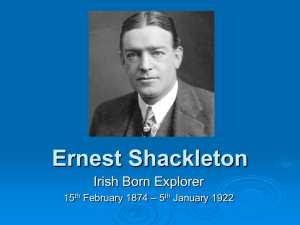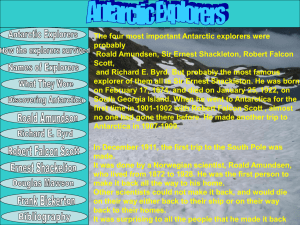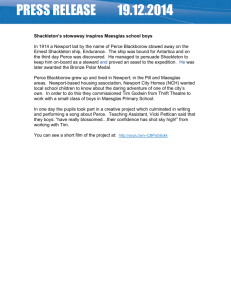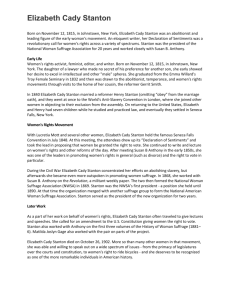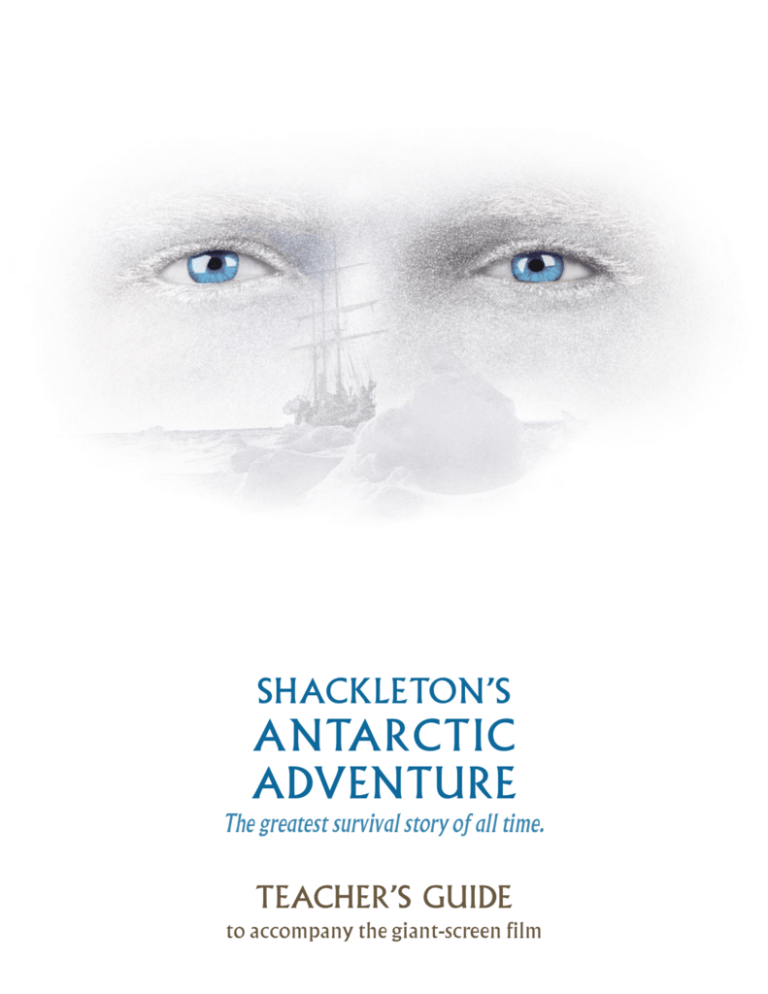
SHACKLETON’S
ANTARCTIC
ADVENTURE
The greatest survival story of all time.
TEACHER’S GUIDE
to accompany the giant-screen film
© 2001 WGBH Educational Foundation
Contents
2
Who Was Sir Ernest Shackleton?
6
A Journey Unexpected
Activity 1: Track the Expedition
Students use latitude and longitude coordinates to track
Shackleton’s epic journey.
10
Ice-Cold Continent
Kelly Tyler/WGBH
Activity 2: All About Antarctica
Students learn basic information about Antarctica and
compare the continent to the places where they live.
12
Seal for Breakfast?
Activity 3: What’s on Your Plate?
Students compare the nutritional value and variety of their
own meals to those eaten by the early Antarctic explorers.
16
In Their Own Words
Activity 4: In Your Words
Students read journal entries written by Shackleton and
his crew and create passages documenting their own lives.
20
Stormy Seas Ahead
Activity 5: Craft the Caird
Students use mathematical scale to create a life-size
outline of the James Caird lifeboat.
The James Caird was the boat that
carried Sir Ernest Shackleton and
five others from Elephant Island to
South Georgia Island in 17 days.
This replica of the Caird was made
especially for the film Shackleton’s
Antarctic Adventure.
22
Activity 6: Find Your Latitude
Students make their own quadrants and use them to
determine their latitude.
24
© 2001 WGBH Educational Foundation
Finding the Way
Resources
3
Who Was
Sir Ernest Shackleton?
Scott Polar Research Institute
Born in 1874 in County Kildare, Ireland, Ernest Shackleton lived with his family first in
Dublin, Ireland, and then in England, where he was educated at Dulwich College. At age 16,
Shackleton joined the British Merchant Navy. A decade later he volunteered to accompany
the National Antarctic Expedition under British Captain Robert Falcon Scott, which
became the first of four polar adventures Shackleton would undertake.
The 1901–1904 Scott expedition aboard the ship Discovery came within a recordbreaking 400 miles (643.7 km) of the South Pole, but was ultimately unsuccessful
in reaching its destination.
Shackleton returned to England, married, and tried to establish a name for himself
in journalism, business, and politics.
Web
Trek
More on Shackleton
www.pbs.org/nova/shackleton/
Find more information about
Shackleton’s expedition,
including sounds and interactive
activities, on Shackleton’s
Antarctic Odyssey, the NOVA/PBS
Online Adventure Web site that
documents the two filming
expeditions in the Antarctic.
At this juncture, Britain had now been “beaten” to both the North and South Poles.
Shackleton set out to gain Britain the honor of what he called “the largest and most striking
of all journeys—the crossing of the Continent.”
To recruit the crew of his British Imperial Trans-Antarctic Expedition, who would sail
aboard the Endurance, it is said that Shackleton posted the following notice:“Men wanted
for hazardous journey. Small wages. Bitter cold. Long months of complete darkness.
Constant danger. Safe return doubtful. Honour and recognition in case of success.”
Shackleton chose 27 men to serve a variety of positions, such as running and navigating
the ship, cooking the meals, and
keeping track of supplies. He also
took scientists,surgeons,a carpenter,
and a photographer on board.The
crew set forth from Buenos Aires,
Argentina, on October 26, 1914.
Endurance crew members pose
beneath the ship’s bow.
4
© 2001 WGBH Educational Foundation
Scott Polar Research Institute
Sir Ernest
Shackleton
By 1908, however, Shackleton was again drawn to the Antarctic. Deciding to
attempt the South Pole trek himself, he raised the funds for his own Nimrod expedition. But the Nimrod’s quest for the Pole failed, too. His crew got within a scant
100 miles (160.9 km) of the Pole—farther south than anyone had gone before—
when Shackleton was forced to turn back because of the party’s ill health and dwindling
supplies.To the dismay of England’s citizens, boasting rights to the Pole went three years
later to Norwegian explorer Roald Amundsen.
Biographers have said that Shackleton was drawn to polar exploration by his romantic,
adventurous nature rather than scientific interest. But Shackleton knew that expeditions
were formally sanctioned by their scientific goals; therefore, he recruited a scientific staff
of four—a biologist, a geologist, a meteorologist, and a physicist.The plan was for these
men to work from their base on the Weddell Sea to investigate Graham Land to the West
and Enderby Land to the East; the Endurance was equipped for dredging and hydrological
work.These original goals were thwarted, so, in the end, the crew’s most significant
contribution to science was its careful record of the Weddell Sea’s infamous drift.
While Shackleton and his crew failed to make the first crossing of the Antarctic continent,
their expedition became a larger-than-life testament to heroism and human endurance,
with all 28 men surviving two years in the barren, frigid Antarctic after their ship, the
Endurance, was caught in pack ice and eventually crushed.
The crew officially dispersed in October 1916, with most of the men returning to England
to serve in World War I.The expedition team was later awarded the Polar Medal, although
Shackleton denied it to four of his men who he seemed to feel had not given their all in that
dire time.
In 1921, Shackleton led his final journey to the Antarctic on the ship Quest, bringing with
him a handful of the original Endurance crew members. But shortly after the start of the
expedition—on January 5, 1922—Shackleton died of a heart attack; he was in his late 40s.
At the request of his wife, he was buried at Grytviken, the South Georgia Island whaling
station that played a pivotal role in his journey of endurance.
65˚W
65˚W
60˚W 55˚W 50˚W
45˚W
40˚W 35˚W
Key
Intended route
Actual route
45˚S
South Georgia I.
WEDDELL
SEA
Vahsel Bay
50˚S
Elephant I.
55˚S
ROSS
SEA
WEDDELL
SEA
ANTARCTICA
Shackleton originally intended to land at
Vahsel Bay and head southwest toward the
Ross Sea. His actual route (inset) was much
different—because the Endurance became
stuck in pack ice, Shackleton and his crew
remained in the Weddell Sea, never actually
setting foot on the continent.
60˚S
Vahsel Bay
65˚S
ANTARCTICA
Note: Shackleton’s routes are approximated.
© 2001 WGBH Educational Foundation
5
Shackleton’s
Antarctic Adventure
The giant-screen film Shackleton’s Antarctic Adventure transports viewers back in time to
experience Sir Ernest Shackleton’s amazing tale of leadership, heroism, endurance, and epic
adventure.The film:
Web
Trek
Film Web Site
www.shackletonsantarctic
adventure.com
Visit the Shackleton’s Antarctic
AdventureWeb site to find e-mail
postcards featuring images from
the film, a downloadable version
of this teacher’s guide, a listing
of special events nationwide,
and more.
• explains that no place on Earth is more hostile to life than Antarctica, which is
surrounded by immense ice floes and gripped by temperatures that dip well
below -100˚F (-73.3˚C) and winds up to 200 miles per hour (321.9 kph). It is the
only continent never permanently settled by people and the last to be explored.
• tells how Shackleton twice attempted to reach the South Pole, only to have it
claimed first by Norwegian explorer Roald Amundsen. Shackleton set a new
goal: He would be the first to cross the entire Antarctic continent, some 1,700
statute miles wide (2,735.8 km).
• describes how Shackleton recruited his 27-man crew of scientists, officers, and
seamen, and how they finally set sail from South Georgia Island in December
1914 for the Weddell Sea coast of Antarctica.
• portrays Shackleton as a man of towering ambition and boundless optimism,
whose crew members dubbed him “The Boss.”
• recounts how his wooden ship, the Endurance, became trapped in the pack ice of
the Weddell Sea before ever reaching Antarctica. For 10 months, the ship drifted,
locked in ice, until millions of tons of moving pack ice pressed against the
Endurance with tremendous pressure, crushing it.
• re-creates life at Patience Camp, the camp on an ice floe where the crew lived
for five months after they had to abandon ship.
• shows how the men played games and engaged in sing-alongs, plays, and skits.
• chronicles how once their camp drifted close to open areas of water, Shackleton
and his men rowed their three lifeboats as far as uninhabited Elephant Island.
• depicts the perilous 800-mile (1,287.5-km) journey made by Shackleton and five
others in a 23-foot (7.0-m) lifeboat called the James Caird through the world’s
worst seas to seek help at South Georgia Island.
• introduces three of today’s most accomplished mountaineers—Reinhold
Messner, Stephen Venables, and Conrad Anker—who retrace Shackleton’s final
leg of the journey to seek help: crossing 26 miles (41.8 km) of mountain peaks
and crevassed glaciers on foot across South Georgia Island to a whaling station.
• reenacts the rescue of all 22 men left on Elephant Island, 22 months after their
initial departure from Buenos Aires, Argentina.
6
© 2001 WGBH Educational Foundation
Frank Hurley, courtesy of The Macklin Collection
When Shackleton purchased
his 144-foot-long (43.8-m),
300-ton, (272.2-metric tons)
wooden sailing ship, it was named
Polaris; he renamed it the Endurance
in honor of his family motto:
Fortitudine Vincimus—“by endurance
we conquer.”
Using This Guide
This guide is intended to be used with the giant-screen film, Shackleton’s
Antarctic Adventure.The multidisciplinary activities presented here are designed
for students ages 7 through 14.
Each lesson features teacher and student pages.Teacher pages include topical
background information and a setup to provide instruction for carrying out
the activity.Web Treks offer more information on each activity topic, and
Extensions offer ideas for augmenting the activity.
Student pages include activity instructions, additional information to help
students understand the activity, and follow-up questions. Additional student
pages provide supplementary material to help students complete the activity.
Curriculum Connections
Activity
1.
2.
3.
4.
5.
6.
Track the Expedition
All About Antarctica
What’s on Your Plate?
In Your Words
Craft the Caird
Find Your Latitude
© 2001 WGBH Educational Foundation
Science
•
•
•
Health
•
Subject
Mathematics Social Studies English
•
•
•
•
•
•
•
•
•
7
Teacher
Page
Web
Trek
Mapping Terra
Incognita
www.pbs.org/nova/shackleton/
surviving/mapping.html
Presents the evolution of
Antarctic mapmaking,
from ancient Roman times
to present day.
Satellite Image
of Antarctica
terraweb.wr.usgs.gov/TRS/
projects/Antarctica/AVHRR.html
Posts various satellite images
courtesy of the U.S. Geological
Survey.
A Journey Unexpected
Background
When Sir Ernest Shackleton and his crew members left South Georgia Island on
December 5, 1914, they sailed south into the Weddell Sea.Their destination was
Vahsel Bay, where they would disembark the Endurance and begin their southwest
trek across the Antarctic continent toward the Ross Sea. Shackleton brought
69 Canadian sledge dogs to aid the expedition’s transcontinental passage, and he
arranged for a separate crew to travel inland from the Ross Sea to deposit additional supplies he and his crew would use during their crossing. Everything
seemed set.
But what Shackleton and his crew members didn’t anticipate was the amount of
pack ice—solid or broken up ocean ice—that they would encounter. And so,
about a month and a half into their journey, they found themselves on a very
different expedition from the one they had so carefully planned: The Endurance
became trapped by pack ice, which crushed the ship 10 months later. This left
Shackleton and his 27 men stranded on the ice with only three lifeboats, limited
provisions for food and shelter, and little hope of rescue.
U.S. Census Bureau
www.census.gov/cgi-bin/
gazetteer
Gives the actual latitude and
longitude of different areas
when town name and zip code
are entered.
Extension
Have students brainstorm and
create alternative ways to
represent the timeline’s events.
Examples include creating a
timeline that is:
• scaled to visually display the
length of time between events.
• illustrated to highlight one
theme that runs through the
time period.
• abbreviated to emphasize key
events.
• presented along with a
simultaneous timeline of events
occurring in other regions or
worldwide.
• audio-recorded and presented
along with visuals.
8
Activity 1 : Track the Expedition
Objective
Students use latitude and longitude
coordinates to track Shackleton’s epic
journey.
Materials for each student
• copy of Track the Expedition
activity sheet on page 7
• copy of The Timeline activity sheets
on pages 8–9
• adhesive tape
Procedure
1. Tell students that Shackleton originally
planned to be the first to cross
Antarctica, but that because his ship got
caught in pack ice, he and his crew
members never actually set foot on the
continent itself. Instead, they found their
ship immobilized,and they had no
knowledge of how long their expedition
would be stalled.
2. Make copies of Track the
Expedition and The Timeline activity
sheets.Tape The Timeline activity
sheets together so that they are sideby-side. Distribute all activity sheets to
students.
3. Have students read The Timeline
once through before they do the mapping
activity.
4. Once everyone has read the timeline,
have students read it again, this time
locating the latitude and longitude
coordinates listed within the text. As
they find each coordinate, have them
map it on their Track the Expedition
activity sheet.
5. When students have completed
the mapping exercise, have them answer
the questions listed on the student
activity page.
© 2001 WGBH Educational Foundation
t
Studen
Page
Track the Expedition
Background
Find out the answers to these questions and
more as you track Shackleton’s extraordinary
journey to and from the Antarctic. Use the map
below with the latitude and longitude coordinates
listed inThe Timeline activity sheets to plot
Shackleton’s journey.
Where did Sir Ernest Shackleton begin his
journey? When did his ship get caught in pack ice?
When did it get crushed? Where were his men
stranded for months?
65˚W
60˚W
55˚W
50˚W
45˚W
40˚W
35˚W
ARGENTINA
50˚S
Punta
Arenas
Equator
Falkland Is.
Latitude
55˚S
CHILE
60˚S
S. Georgia I.
Ushuaia
Elephant I.
S. Orkney Is.
DRAKE
PASSAGE
S. Sandwich Is.
Paulet I.
65˚S
Prime
Meridian
Antarctic
Peninsula
70˚S
International Date Line
WEDDELL SEA
Longitude
Antarctic Circle
Ronne Ice Shelf
Vahsel Bay
Coats Land
A N TA R C T I C A
Questions
1. What were the northernmost and
3. In degrees of latitude, about how far is
southernmost lines of latitude that the
Endurance passed through?
Coats Land, Antarctica, from the equator,
which lies at 0° latitude?
2. What were the easternmost and
westernmost lines of longitude?
4. In degrees of latitude, about how far is
© 2001 WGBH Educational Foundation
the South Pole, which lies at 90°S, from the
North Pole, which lies at 90°N?
About Latitude
and Longitude
Latitude lines represent
the distance north or
south of the Earth’s
equator. Longitude lines
represent the distance
east or west of the prime
meridian, or the
International Date Line.
Both are measured in
angular degrees. On this
map, Punta Arenas, Chile,
is located at a latitude of
53°S and a longitude of
71°W.
Note: Coordinates in this activity
approximate Shackleton’s journey.
Student
Page
The Timeline
1914
August 1
August 3
August 8
October 26
The Endurance departs
London, England, the same day
Germany declares war on
Russia.
Sir Ernest Shackleton offers his
ship and crew to the British
government for the war effort.
After Shackleton receives a
one-word telegram from the
Admiralty (“Proceed”), the
Endurance departs Plymouth,
England.
With the final crew on board,
the Endurance leaves Buenos
Aires, Argentina, for South
Georgia Island.
The Endurance
1915
December 30
January 10
January 18
February 22
The Endurance crosses the
Antarctic Circle.
The Endurance crew first
sights the Antarctic continent
(Coats Land).
Lat: 72°S – Long: 16°W
The Endurance becomes
trapped in the pack ice.
Lat: 77°S – Long: 30°W
The Endurance drifts to its
farthest point south.
Pack ice
September 2
October 27
November 1
November 21
Pressure from the ice makes
the Endurance, according to
steward Perce Blackborow,
“literally [jump] into the air
and [settle] on its beam.”
At 5 p.m., Shackleton gives the
order to abandon the
Endurance.
After a futile, three-day
attempt to march over the ice,
Shackleton has the crew erect
Ocean Camp on an ice floe.
With a single cry of “She’s
going, boys!” Shackleton
and his crew watch the
Endurance sink.
Lat: 68°S – Long: 52°W
March 17
March 31
April 7
April 9
The crew’s camp drifts
to about 40 miles (64.4 km)
south of Paulet Island.
Lat: 63°S – Long: 54°W
The ice floe that the men are
living on splits in two,separating
them from their three
lifeboats, which are later
recovered.
Elephant Island appears on the
horizon.
The crew goes to sea in the
three lifeboats, the James Caird,
the Dudley Docker, and the
Stancomb Wills.
Elephant Island
May 10
May 19
May 20
May 23
After 17 days in stormy seas,
and with superior navigation by
Endurance Captain Frank
Worsley, the Caird miraculously
arrives on the west coast of
South Georgia.
Lat: 54°S –
Long: 38°W
Shackleton,Worsley, and
Second Officer Tom Crean
set off to cross the previously
unexplored interior of South
Georgia, heading toward
the east coast’s whaling
stations.The other
three men remain behind.
Having trekked without a
break for 36 hours over
glaciers and mountains,
Shackleton,Worsley, and
Crean arrive at Stromness
whaling station.
Picking up the other three men
on the west coast of South
Georgia, Shackleton,Worsley,
and Crean depart on the
English-owned Southern Sky
to rescue men on Elephant
Island, but are stopped by ice
100 miles (160.9 km) short
of land.
South Georgia
© 2001 WGBH Educational Foundation
t
Studen
Page
November 5
December 5
December 7
December 12
The Endurance arrives at
Grytviken whaling station on
South Georgia Island.
Lat: 54°S – Long: 36°W
The Endurance departs
Grytviken, South Georgia
Island.This is the last time
the crew would touch land
for 497 days.
The Endurance enters Antarctic
pack ice.
Lat: 57°S – Long: 25°W
The Endurance continues
advancing through the pack ice.
Lat: 60°S – Long: 18°W
Whaling station
February 24
May 1
May 2
June 22
Shackleton orders a halt
to the ship’s routine.
The sun vanishes for the
season, not to reappear for
four months.
Noon temperatures are
-5°F (-20.6°C).
Lat: 75°S – Long: 42°W
The crew celebrates
Midwinter’s Day with a feast.
1916
December 23
December 29
January 21
February 29
The crew again begins marching
toward open water, averaging
just a mile and a half a day.
Shackleton abandons the
march; the crew sets up
Patience Camp
on the ice.
A blizzard blows the
ice floe on which the camp
is located north across the
Antarctic Circle.
In honor of Leap Year Day, the
crew enjoys three full meals.
Patience Camp
April 16
April 17
April 20
April 24
After seven grueling days at
sea, the lifeboats land safely
on Elephant Island at Cape
Valentine.
Lat: 61°S – Long: 55°W
Shackleton moves camp seven
miles to the west, to a spot that
comes to be known as Point
Wild—named after Frank
Wild, the Endurance crew
member who found it.
Shackleton announces that he
will attempt to sail the 23-foot
(7.0-m) James Caird 800 miles
(1,287.5 km) to South Georgia
Island.
Shackleton and five others
depart for South Georgia in
the Caird.
June 17
July 12
August 25
The Uruguayan government
loans Shackleton the survey
ship Instituto de Pesca No.1,
which comes within sight of
Elephant Island before accumulating pack ice turns it back.
Shackleton sets out from
Punta Arenas, Chile, on Emma,
a schooner chartered by the
British Association, but only
gets to within 100 miles (160.9
km) of Elephant Island
before storms and ice
force it to return.
Chilean authorities loan
Shackleton the Yelcho, a small
steamer, which sets sail from
Punta Arenas with Shackleton,
Worsley,and Crean for Elephant
Island.
Lat: 53°S –
Long: 71°W
The James Caird
August 30
TheYelcho
© 2001 WGBH Educational Foundation
“ I felt jolly near blubbing for a
bit & could not speak for
several minutes,” Frank Wild
wrote about seeing Shackleton
arrive with the Yelcho, which
rescued the crew on this day
in 1916, 22 months after they’d
set out from Buenos Aires,
Argentina.
Lat: 61°S – Long: 55°W
Teacher
Page
Web
Trek
Explore Antarctic
Islands
www.pbs.org/nova/shackleton/
1999/islands.html
Displays 360-degree QuickTime
virtual reality scenes of the
Drake Passage, the Weddell Sea,
and the Antarctic islands.
CIA World Factbook
www.odci.gov/cia/publications/
factbook/index.html
Features information about individual countries as compiled for
the Central Intelligence Agency.
Ice-Cold Continent
Background
Antarctica is one of the most remote and hostile places on Earth; it was the last
continent to be explored.When Sir Ernest Shackleton and his crew started their
1914 journey to the continent, no one had yet successfully crossed it from sea
to sea.Today, the ice-laden region hosts about 4,000 scientists and visitors during
the Antarctic summer. As the fifth largest continent, Antarctica comprises
about 10 percent of the Earth’s land surface and lays claim to being the coldest
and windiest continent on the planet. Seventy percent of the world’s fresh water
resides there.
Antarctica is governed by the international Antarctic Treaty of 1959, which
establishes the continent as an area of scientific research.The treaty prohibits
military activity like weapons testing, but military personnel and equipment may
be used for scientific research or peaceful purposes. A special protocol to the
Treaty in 1991 added environmental protection measures. One measure was the
banning of non-indigenous species, so all sled dogs were airlifted to a new home
in arctic Canada.
The 50 States
www.50states.com
Offers links to state facts such as
climate, economy, and geography.
Activity 2 : All About Antarctica
State Fact Sheets
www.ers.usda.gov/epubs/other/
usfact
Lists state-specific facts on population, employment, income,
and agriculture.
Counties of England
www.camelotintl.com/heritage/
counties/england/index.html
Offers facts and short features
about each of England’s counties.
Extension
Objective
Students learn basic information about
Antarctica and compare the continent
to the places where they live.
• How many people live there? What
kind of work do they do?
Materials for each student
2. After students have answered these
• copy of All About Antarctica
activity sheet on page 11
• access to print or Internet resources
that include information about where
students live
Procedure
1. Ask students what they know about
Antarctica. Specifically:
Have students find ways to
visually represent the differences
between their home and
Antarctica, such as showing the
difference in size between the
two locations or the different
kinds of wildlife that exist in
each place.
12
• How big do they think it is compared
to where they live?
• How cold is it compared to where
they live?
• What does the landscape look like?
• What kind of wildlife lives there?
questions,organize them into groups and
give each group a copy of the All About
Antarctica activity sheet.Review with
students the various facts about
Antarctica found on the student page.
3. Have students use print and Internet
resources to find out information about
where they live. As students find the
information, have them fill in the chart
comparing facts about their home to
facts about Antarctica.
4. Once students have completed the
chart, have them answer the questions
listed on the student activity page.
© 2001 WGBH Educational Foundation
t
Studen
Page
All About Antarctica
Antarctica is vast and cold. But what does that mean exactly? One way to
understand what it is like in Antarctica is to compare it to something that
you are already familiar with—like where you live now. Look at all the facts
below about Antarctica and see if you can find information for the same
categories about your home.Then compare how Antarctica and your home
are alike and contrast how they are different.
Features
About Living
in Antarctica
Did you know that the Antarctic
winter happens during June, July,
and August? And that “night” is
theoretically six months long at
the geographic pole, where it is
continuously twilight or dark
during the winter months? The
height of Antarctic summer is in
January, bringing 24 hours of
continuous sunlight.
Facts About
Where I Live
Land area
Average temperature
Average rainfall
Average elevation
Typical terrain
Government
Land area
5,500,000
square miles
(14,000,000
sq km)
Population size
Common life forms
Natural resources
Average rainfall
2–4 inches (5.0–10.2 cm) (est.)
Questions
Typical terrain
rocks, snow, and ice
1. What are the biggest differences
between Antarctica and the place
where you live?
2. What features seem to be the
most alike?
3. What do you think would be
the most difficult part about living
in Antarctica?
Population size
less than 4,000,
mostly scientists
Common
life forms
seals, whales,
penguins, moss
Government
International
Treaty
Average
temperature
-57°F (-49.4°C)
Average elevation
7,500 feet (2,286 m)
Natural resources
almost none;
a little whaling
A N TA R C T I C A
© 2001 WGBH Educational Foundation
Teacher
Page
Web
Trek
Food and Nutrition
Information Center
www.nal.usda.gov/fnic/
Provides links to numerous
nutrition resources, including
young children and ethnic/
cultural food guide pyramids.
Health Finder for Kids
www.healthfinder.gov/kids/
home.htm
Offers kid-friendly health
information, along with related
activities and games.
Seal for Breakfast?
Background
Dietary guidelines recommend that Americans’ diets consist of fat at approximately
30 percent of calories; protein at about 10 percent; and carbohydrates at about 60
percent; the explorers’ diets near the end of the Endurance crew’s journey were
comprised mainly of protein and fat. At this point,crew members neither consumed
enough calories nor did they have the variety (carbohydrates and certain vitamins)
in their diets necessary to fulfill basic nutritional requirements. One of the most
difficult times for crew members was when they were forced to eat the dogs to
survive. In his memoir, Sir Ernest Shackleton remembers:“It was the worst job that
we had had throughout the Expedition, and we felt their loss keenly.”
In terms of calories, teenage girls should consume about 2,200; teenage boys about
2,800.The U.S. Department of Agriculture (USDA) recommends that a 2,200calorie diet include the following servings: 9 grain group, 4 vegetable group, 3 fruit
group, 3 milk group, and 6 ounces of the meat group (total fat equals 73 grams).
For a 2,800-calorie diet, the USDA recommends: 11 grain group, 5 vegetable group,
4 fruit group,3 milk group,and 7 ounces of the meat group (total fat equals 93 grams).
Extension
Have students list all the food
they would ideally take on an
expedition to a freezing-cold
climate.Then have them consider
why this food would or would
not be good to bring (for
example, weight, perishability,
nutrition, variety) and revise
their lists based on the discussion.
How many of their foods would
make the revised list? What
kinds of new foods would they
now consider?
Activity 3 : What’s on Your Plate?
Objective
Students compare the nutritional value
and variety of their own meals to those
eaten by the early Antarctic explorers.
Materials for each student
• copy of the What’s on Your Plate?
activity sheet on page 13
• copy of the Calorie Counts activity
sheets on pages 14–15
• additional print and Internet
references for calorie counts
Procedure
1. Tell students that when Sir Ernest
Shackleton and his men started their
journey, they had a variety of foods to
meet their nutritional needs. But six
months before they were rescued, their
diet was mainly seal steaks, stewed seal,
penguin steaks, stewed penguin, and
penguin liver.
14
2. Organize students into teams and
distribute the What’s on Your Plate?
and Calorie Counts activity sheets.
Have students characterize the food
listed in the explorers’ meal charts by
placing a check in the appropriate food
category or categories (carbohydrate,
protein, and/or fat).Then have students
add up the estimated calories that crew
members consumed.
3. Have students fill in the charts with
what they ate yesterday for breakfast,
lunch, and dinner.Then have students
categorize their meals (some foods may
qualify for more than one category) and
use the information listed in Calorie
Counts and other resources to find
their total daily calories consumed.
4. When students are finished, have them
answer the questions listed on the student
activity page.
© 2001 WGBH Educational Foundation
t
Studen
Page
What’s on Your Plate?
How does the food you eat compare to what
Endurance crew members ate at the beginning and
later on in their Antarctic voyage? To compare,first
categorize the kind of foods the explorers ate,and
then use the Calorie Counts activity sheets and
other resources to examine the kind of foods you eat.
Enter everything you had for breakfast, lunch, and
dinner yesterday.When you’ve finished, put a mark
in the box or boxes that most closely describes the
type of food you ate.Then add your total calories
together and compare your daily menu to some of
those of Shackleton and his crew.
Your meals
Endurance crew meals
Breakfast
A representative meal
at the beginning of the expedition
Food
Quaker Oats
Food
Carbohydrate Protein Fat Calories*
Carbohydrate Protein Fat Calories*
350
Tinned meat
Bacon
Dried fruit
Cocoa
500
300
300
100
Total
Total
Lunch
Food
Carbohydrate Protein Fat Calories*
A representative meal
later on in the expedition
Food
Seal steak
Penguin liver
Carbohydrate Protein Fat Calories*
800
800
Boiled
seaweed
100
Tea with sugar
30
Total
Dinner
Food
Carbohydrate Protein Fat Calories*
Total
About Food
Categories
There are three main food
groups: carbohydrates, fats,
and proteins. Carbohydrates
are foods like oatmeal, bread,
cereal, potatoes, rice, pasta,
fruits, and vegetables; fats
primarily include oils and fats
from meat and dairy products; and proteins come in
the form of nuts, fish, meat,
poultry, eggs, and beans.
© 2001 WGBH Educational Foundation
* Estimated calorie counts
Total
Questions
1. What type of food did you eat most
in the meals above?
of? Least of?
4. How do each of your meals compare
2. What percentage of each food group
would you estimate you ate?
with the explorers’ meals at different
times during the journey?
3. What percentage of each food
5. What do you think your energy needs
group did Shackleton and his men eat
are compared to those of the explorers?
Student
Page
Calorie Counts
The following are the calorie values for some foods you may commonly eat for breakfast, lunch, or dinner. If you don’t see a particular food in one category, check for it in a
different category. Use additional resources to find foods that are not listed here.
Beverages
130
1 English muffin, plain
120
1 cup 2 percent milk
100
1 waffle, from frozen
180
1 cup 2 percent chocolate milk
165
1 plain cake doughnut
180
1 cup 2 percent chocolate milk
395
1 plain danish pastry
0
8 ounces brewed tea, plain
230
1 croissant
80
1 cup orange juice, canned
95
1 large fried egg
85
1 cup apple juice, canned
80
1 large poached egg
110
1 cup cranberry juice, bottled
150
1 packet instant oatmeal, flavored
100
8 fluid ounces lemonade, from frozen
110
1 ounce Cheerios cereal
12 fluid ounces diet cola
110
1 ounce corn flakes
5
125
8 fluid ounces grape soda, canned
355
1 10-ounce vanilla shake
70
110
While these foods are
representative of their groups,
most foods—including these—
contain a variety of components.
1 plain bagel
100
1 ounce cream cheese
230
8 ounces whole-milk yogurt. flavored
105
1 banana
1 ounce Rice Krispies cereal
Snack/Lunch foods
Breakfast foods
165
1 ounce All-Bran cereal
30
5
40
160
40
1 carrot, raw
1 stalk celery, raw
1 snack-pack raisins
1 ounce cashews,dry- or oil-roasted
1 peanut butter cracker sandwich
25
1⁄ 2 cup cantaloupe, cubed
35
1⁄ 2 cup grapefruit, sectioned
105
10 potato chips
80
1 medium apple
150
1 ounce corn chips
40
1⁄ 2 cup blueberries, raw
20
10 pretzel sticks
25
1⁄ 2 cup strawberries, raw, sliced
30
1 cup popcorn, air-popped
35
1 pat salted butter
50
1 tablespoon jelly
115
65
1 slice white bread
50
1 tablespoon jelly
60
1 slice whole wheat bread
95
1 tablespoon peanut butter
70
1 slice raisin bread
100
1 tablespoon regular mayonnaise
165
1 blueberry muffin
110
3 ounces tuna, canned in water
125
1 bran muffin
180
2 slices beef or pork bologna
5
1 dill pickle
1 pita bread, whole wheat
*Source: U.S. Department of Agriculture
© 2001 WGBH Educational Foundation
t
Studen
Page
115
1 ounce Cheddar cheese
25
1 tablespoon parmesan cheese, grated
105
1 ounce American cheese
140
1⁄ 2 skinless chicken breast, roasted
105
1 ounce Swiss cheese
365
1 breast chicken, batter-fried
85
1 cup tomato soup, made with water
290
3 ounces pork chop, broiled
75
1 cup chicken noodle soup, canned
240
3 ounces sirloin steak, broiled
325
1 enchilada, with beef and cheese
110
3 ounces haddock, baked or broiled
150
1 cup macaroni & cheese, from mix
145
3 ounces salmon, baked or broiled
255
1 slice cheese pizza
470
110
1⁄ 2 cup creamed cottage cheese,
65
1⁄ 2 cup green peas, cooked
small curd
15
4 medium spears asparagus, cooked
95
1 cup sweetened applesauce, canned
25
1⁄ 2 cup broccoli, cooked
50
1⁄ 2 sweet cherries, raw
20
1⁄ 2 cup spinach, cooked
65
1 medium nectarine, raw
40
1⁄ 2 cup winter squash, baked
60
1 medium orange, raw
80
1 ear corn, cooked
90
1 slice watermelon
5
100
1 medium pear, raw
40
70
1 popsicle
25
1 medium tomato, raw
95
1 ounce jelly beans
20
1⁄ 2 cup green pepper, raw
145
1 sponge snack cake, without frosting
85
1 dinner roll
120
2 oatmeal raisin cookies
80
175
1 brownie with nuts & frosting
110
2 fig bar cookies
100
2 chocolate chip cookies, homemade
Dinner foods
130
1 slice Quiche Lorraine
1 cup loose-leaf lettuce
1⁄ 2 cup onion, raw, sliced
2 onion rings, breaded, from frozen
1⁄ 2 cup potato salad
made with mayonnaise
110
1⁄ 2 cup mashed potatoes, from flakes
220
1 baked potato, with skin
115
1⁄ 2 cup brown rice, cooked
230
3 ounces ground beef, lean, broiled
110
1⁄ 2 cup white rice, cooked
130
1 hamburger roll
145
1 piece angel food cake, from mix
150
1 beef or pork hot dog
455
130
1 hot dog roll
70
1 piece apple pie, double crust
1⁄ 2 cup gelatin dessert
1 teaspoon yellow mustard, prepared
160
1⁄ 2 cup instant chocolate pudding
20
1 tablespoon sweet relish
350
1 cup premium vanilla ice cream
20
1 tablespoon catsup
5
0
58
150
70
1 fruit juice bar, frozen
1 teaspoon salt
155
1 chocolate cupcake, with frosting
1 fish stick, from frozen
105
1⁄ 2 cup yogurt, frozen
1 cup plain spaghetti noodles, cooked
© 2001 WGBH Educational Foundation
Teacher
Page
Web
Trek
Dispatches
www.pbs.org/nova/shackleton/
dispatches/
Provides present-day observations from a correspondent who
traveled to the Antarctic with
the film crew that produced
Shackleton’s Antarctic Adventure.
The Ice
In Their Own Words
Background
Without the diaries of Sir Ernest Shackleton and other Endurance crew members,
people would be left to wonder exactly what happened to the men. For 22
months, the men protected their personal diaries, which captured everything
from daily facts to personal feelings.
What makes the journals of the Endurance crew so interesting is that the men
recorded not only the facts about what was happening to them, but also how
they felt about what was happening and how they felt about each other.While
much of what occurred to Shackleton’s men was high adventure, many days were
extremely boring.Yet, the men kept writing it all down in a way that still makes us
want to read it today.
www.theice.org/
Details what it’s like to work in
Antarctica from a technician
who travels there each year.
Includes essay entries from people who have lived and worked in
Antarctica.
The Write Site
www.writesite.org
Offers interactive language arts
and journalism activities for kids
and includes advice about how
to keep a journal.
Activity 4 : In Your Words
Objective
Students read journal entries written
by Shackleton and his crew and create
passages documenting their own lives.
Entries activity sheets that represent
viewpoints of different crew members.
Materials for each student
about the language that makes the diary
extracts interesting.Which entries do
they enjoy more—the ones using just
factual language or those revealing a
more personal experience? Why?
• copy of In Your Words activity sheet
on page 17
• copy of Journal Entries activity
sheets on pages 18–19
Extension
Ask students to write a passage
detailing what they remember
about the last time that their
class met.What do they remember most? What was the topic of
discussion? Who asked questions?
Which students were in attendance or absent? Have students
write everything they can
remember and then compare
different students’ recollections.
How similar were the accounts?
How different were they and in
what ways? What might explain
the differences?
18
Procedure
1. Tell students that some members of
Shackleton’s crew kept journals for
almost two years, chronicling different
aspects of the journey.
2. Distribute copies of the InYour
Words and Journal Entries activity
sheets to each student. Have students
read the excerpts on the Journal
3. Have students identify what it is
4. After students have analyzed and
discussed the passages, have them write
their own journal entries describing
their day.
5. When students have completed their
journal entries, have them answer the
questions listed on the student activity
page.
© 2001 WGBH Educational Foundation
t
Studen
Page
In Your Words
Read the excerpts on the Journal Entries activity
sheets to see the kinds of things that Sir Ernest
Shackleton and his men thought about when they
wrote their journal entries.Then write about your
own day.
Think about why events from today stand out in
your mind. For example, instead of noting “The bus
was late this morning, and I missed the first part
of gym,” think about how you could more fully
describe what happened.
For example:
• “I paced around, feeling really angry about
being kept waiting.”
• “It was raining—my shoes got soaked.”
• “I heard the bus before I saw it; the gears
were grinding out loud as it turned onto
my street. I felt so relieved!”
About Feelings
Facts alone don’t tell a story.
As you think about your day,
consider whether you felt any
of the following:
• bored
• frustrated
• comfortable
• mad
• disappointed
• nervous
• excited
• overwhelmed
• great
• proud
• happy
• sad
• loved
• shy
Questions
1. What was the easiest part of
your day to remember? The most
difficult?
2. List all the feelings you had
today. Which one was the
strongest?
3. Think about your day one week
ago. What can you remember?
How do the facts differ from what
you remembered about your day
today?
© 2001 WGBH Educational Foundation
Student
Page
Journal Entries
“This is not a pleasant job. We have to dig a hole down
through the coal while the beams and timbers groan and
crack all around us like pistol-shots. The darkness is almost
complete, and we mess about in the wet with half-frozen
hands and try to keep the coal from slipping back into the
bilges. The men on deck pour buckets of boiling water from
the galley down the pipe as we prod and hammer from
below, and at last we get the pump clear, cover up the bilges
to keep the coal out and rush on deck, very thankful to find
ourselves safe again in the open air.”
—Frank Worsley, writing about having to go down
in the bunkers of the Endurance and clear ice
from the bilge pumps a few days before the crew
was forced to abandon the ship (1)
The Endurance
“In addition to the daily hunt for food, our time was passed
in reading a few books that we had managed to save from
the ship. The greatest treasure in the library was a portion
of the Encyclopædia Britannica. This was being
continually used to settle the inevitable arguments that
would arise. The sailors were discovered one day engaged
in a very heated discussion on the subject of Money
and Exchange. They finally came to the conclusion that
the Encyclopædia, since it did not coincide with their
views, must be wrong.”
“There are no spoons, etc., to wash, for we
each keep our own spoon and pocket-knife
in our pockets. We just lick them as clean
as possible and replace them in our pockets
after each meal. Our spoons are one of our
indispensable possessions here.”
—Shackleton, describing an occurrence
at Ocean Camp in his memoir of the
Endurance voyage (2)
—A crew member writing about daily rituals
at Ocean Camp (3)
© 2001 WGBH Educational Foundation
t
Studen
Page
“It’s a hard, rough, jolly life, this marching and
camping; no washing of self or dishes, no undressing,
no changing of clothes. We have our food anyhow …
sleeping almost on the bare snow and working as
hard as the human physique is capable of doing on a
minimum of food.”
—A crew member recording what it was like
to leave the tedious life of Ocean Camp
and begin a march toward open water (4)
Elephant Island
“The hut grows more grimy every day.
Everything is sooty black. We have arrived at
the limit where further increments from the
smoking stove, blubber lamps, and cooking gear
are unnoticed. It is at least comforting to feel
that we can become no filthier. … From time to
time we have a spring cleaning, but a fresh
supply of flooring material is not always available, as all the shingle is frozen up and buried
by deep rifts. Such is our Home Sweet Home.”
—A crew member writing about living
conditions at their Elephant Island camp (5)
“It had been arranged that a gun should be fired
from the relief ship when she got near the island.
Many times when the glaciers were ‘calving,’ and
chunks fell off with a report like a gun, we thought
that it was the real thing, and after a time we got
to distrust these signals. As a matter of fact, we
saw the Yelcho before we heard any gun. It was
an occasion one will not easily forget.”
—Second-in-Command Frank Wild, recounting the
crew’s rescue from Elephant Island, more than four
months after Shackleton and five others had left the
island to secure rescue (6)
The Yelcho
Sources
(2) Shackleton. South, 93–94.
(1) Shackleton, Ernest. South: A Memoir
of the Endurance Voyage. New York: Carroll (3) Shackleton. South, 93.
(4) Shackleton. South, 104–105.
& Graf Publishers, Inc., 1998, 73.
© 2001 WGBH Educational Foundation
(5) Shackleton. South, 231.
(6) Shackleton. South, 222–223.
Teacher
Page
Web
Trek
The James Caird
Sets Sail
www.pbs.org/nova/shackleton/
dispatches/19991108.html
Tells how the Caird replica used
in Shackleton’s Antarctic Adventure
was built and filmed.
Shackleton’s Antarctic
Adventure
www.shackletonsantarctic
adventure.com
Stormy Seas Ahead
Background
Once Sir Ernest Shackleton and his crew made it to Elephant Island, Shackleton
was faced with an enormous decision: Stay on the uninhabited island through the
winter or sail to the whaling station on South Georgia Island, braving 800 miles
(1,287.5 km) of difficult seas in one of their small lifeboats to do so. Shackleton
chose the latter, and had his carpenter, Chippy McNeish, modify the 23-foot
(7.0-m) James Caird to make it as seaworthy as possible.
On April 24, 1916, Shackleton and five others set out to try to reach civilization
and secure rescue for themselves and the 22 men waiting on Elephant Island.
They braved stormy seas, switching off shifts so that three men would sleep
below while the others steered, sailed, and bailed water from the boat. After 17
days at sea, the men landed on the remote but inhabited island of South Georgia.
Provides additional information
about the Caird.
The James Caird
Society
www.dulwich.org.uk/history/
jamescaird.htm
Provides facts about and photos
of the lifeboat that made the epic
open-sea voyage in 1916.
Extension
Have each student choose an
object in the room, measure it,
and create a scaled-down drawing
of the object.Tell students to
record the scale used on the
paper. Once they are finished,
have students trade papers and,
using the scales provided,
calculate the original dimensions
of the chosen object.
*Note: Caird replica dimensions
based on measurements of the
present-day Caird.
22
Activity 5 : Craft the Caird
Objective
Students use mathematical scale to
create a life-size outline of the James
Caird lifeboat.
Materials for each student
• copy of Craft
the Caird
activity sheet
on page 21
• measuring tape
• string
• scissors
• adhesive tape
Procedure
1. To help demonstrate to students
how cramped the Caird was for the six
adult men, tell them they will map out
the actual dimensions of the Caird replica
used in Shackleton’s Antarctic Adventure.
2. Organize students into groups and
give each group a copy of the Craft the
Caird activity sheet.Tell students to
use the scale—1 inch = 3.3 feet
(2.5 cm = 1.0 m)—to calculate lifesize proportions of the boat.The
dimensions of the Caird replica and the
rounded-off dimensions used in the
activity follow. Students should also
round off their own calculations.
Caird replica*
Activity
length:
23.2 feet (7.1 m)
23.0 feet (7.0 m)
width:
6.8 feet (2.1 m)
7.0 feet (2.0 m)
depth:
~2.6 feet (0.8 m)
(amidships)
2.5 feet (0.8 m)
3. After calculating the actual dimensions,
have students measure out and mark
each off with the string,cutting,and taping
each down.For the height measurement,
students should measure out and cut a
piece of string to the correct size.
4. When students have finished, group
them into sets of six and have each set
take a turn standing in the cabin space.
Have one student hold the 31-inch
(0.8-m) string at the boat’s middle to
represent the vessel’s maximum depth.
5. After all groups have tried out the
cabin,have students work in their original
groups to answer the questions listed
on the student activity page.Then have
students work independently to write
essays describing how they think it
might have been for the Caird crew.
© 2001 WGBH Educational Foundation
t
Studen
Page
Craft the Caird
Sir Ernest Shackleton had three lifeboats from which
to choose for his journey. He chose the James Caird
because it was the largest of the three. Shackleton
had the Caird modified to make it as seaworthy as
possible, including outfitting the top with a canvas
cloth to try to keep the men dry and warm.
In addition, the Caird needed to bring along extra
weight, called ballast, to keep the boat from tipping
over.The crew filled the boat bottom with about
1,800 pounds (816.5 kg) of rocks and gravel, which
all six men had to both crawl around and sleep on.
How big was the Caird? To find out, use the information on this page to scale up the total length, width,
and depth of the Caird replica used in Shackleton’s
Antarctic Adventure.Then use your string, scissors,
and tape to make an outline of the boat’s dimensions.
About the Caird
Besides the men,supplies such as stoves, paraffin, matches,
and sleeping bags had to be carried on the journey.
According to Shackleton’s memoir,the food and instruments
they brought along included:
Food
Scale
1 inch = 3.3 feet (2.5 cm = 1.0 m)
Instruments
• 3 cases sledgling rations
• sextant
• 2 cases nut food
• binoculars
• 2 cases biscuits
• prismatic compass
• 1 case lump sugar
• sea anchor
• 30 packets of Trumilk
• charts
• 1 tin of Bovril cubes
• aneroid
• 1 tin of Cerebos salt
• 36 gallons of water
• 250 pounds of ice
Questions
1. What do you think were the three most difficult conditions for the six Caird crew members’ 17-day journey?
2. What might you think about during such a journey?
© 2001 WGBH Educational Foundation
3. Besides sailing the boat and bailing out water, what
other factors would you need to consider in order to
survive?
Teacher
Page
Web
Trek
Navigate
the High Seas
www.pbs.org/nova/shackleton/
navigate/
Describes how to use a sextant,
how the global positioning
system works, and how to
determine longitude in three
online interactive activities.
Finding the Way
Background
Without ways to navigate, Sir Ernest Shackleton and his crew would never have
been able to determine where they were.Navigation became especially important
when Shackleton and five others struck out for South Georgia Island in a small
boat, the James Caird, with only a sextant to guide them. (A sextant measures the
angle between two points.)
A sextant is only one of the many ways early mariners used to navigate; another
tool they used was called a quadrant.The quadrant,which was popular with
Portuguese explorers like Columbus,came into widespread use around 1450 A.D.
Celestial Navigation
from Argonauts to
Astronauts
www.mat.uc.pt/~asalves/
H61iflan.htm
Reviews early navigation instrumentation, including quadrants,
astrolabes, and sextants.
Ursa Minor
www.astro.wisc.edu/~dolan/
constellations/constellations/
Ursa_Minor.html
Shows a diagram and provides
directions for locating the star
Polaris, which lies in the Ursa
Minor constellation.
Activity 6 : Find Your Latitude
Objective
Students make their own quadrants and
use them to determine their latitude.
Materials for each student
• 2 copies of Find
Your Latitude
activity sheet
on page 23
• a ruler
• a manila folder
• a pair of scissors
• a 10-inch
(25.4-cm) piece
of string
• a weight, such as
a large metal nut
or bolt
• glue
• tape
Extension
Procedure
1. Give each student two copies of the
Have students research and
explain how some other early
celestial navigational instruments
work, such as the:
Find Your Latitude activity sheet.
Have them use one copy to make the
quadrant and save the other to help find
the star Polaris in the night sky.
• kamal
• astrolabe
• cross-staff
• back-staff
2. Have students glue the quadrant
diagram onto the manila folder, cut it
out, and make a hole at the point
marked by an “X,” through which they
will push the end of a 10-inch (25.4-cm)
piece of string. Have them tape the end
of the string to the back of the folder.
3. Then have students attach a weight at
the other end of the string and tape the
90° end of their quadrant diagram to
the 1-inch (1-cm) end of the ruler.
4. Once the quadrant is made, have
students try it out at night with an adult.
5. Tell students that while people in the
Northern Hemisphere can use Polaris
to find their latitude,Shackleton couldn’t
see the North Star from the Antarctic.
Instead, Endurance captain Frank
Worsley, the navigator, mainly relied on
a sextant.
6. When students have tried out the
quadrant, have them answer the questions listed on the student activity page.
• octant
• sextant
24
© 2001 WGBH Educational Foundation
t
Studen
Page
Find Your Latitude
Do you want to determine your latitude? All you
need to do is find the angle between your position
on Earth and the North Star—called Polaris—
and you can figure out your latitude. How do you
do that? Build a quadrant, using the pattern and
instructions below.
Once you have made your quadrant, try it out.
Go out on a clear night and locate the Big Dipper,
also known as The Plough, which will point you to
the star Polaris. Raise your quadrant to your cheekbone (careful you don’t poke yourself!) and, looking
down the length of the ruler, line up Polaris with the
end of the ruler. Once you have Polaris correctly
sighted, press the string against the cardboard and
record the angle at which the string crosses the
scale.This is your latitude.
About Polaris
Relative to the Earth’s movement,
Polaris remains fixed in one
position in the sky,almost exactly
above the North Pole.You can
use this fact to determine your
latitude. Measuring the angle
between your position on Earth
and Polaris reveals the altitude
of Polaris, which is equal to your
latitude.
Questions
1. What is your latitude?
3. What would your latitude be if you
2. What would your latitude be if you
were standing at the equator?
were at the North Pole?
4. How many degrees are you away
from the North Pole? The equator?
© 2001 WGBH Educational Foundation
Resources
Shackleton’s Expedition
General Antarctic
Books
Books
Alexander, Caroline. The Endurance:
Shackleton’s Legendary Antarctic
Expedition. Bloomsbury, U.K.: Knopf,
U.S.A., 1998. Blends storytelling with Frank
Hurley’s expedition photography to chronicle
the 22-month epic of survival. Uses excerpts
from many previously unavailable journals
and documents. Published in association
with the American Museum of Natural
History for its exhibit of the same name.
Armstrong, Jennifer. Shipwreck at the
Bottom of the World: Shackleton’s
Amazing Voyage. New York: Crown, 1998.
Recounts the expedition of Sir Ernest
Shackleton and the crew of the Endurance.
Bickel, Lennard and Rt. Hon. Lord
Shackleton. Shackleton’s Forgotten Men:
The Untold Tale of an Antarctic Tragedy.
New York, NY:Thunder’s Mouth Press, 2000.
Relates the tale of the Endurance’s supply
party, which set out separately on the other
side of Antarctica to leave supplies for
Shackleton’s crew.
Collier, Graham and Patricia Collier
(Photographer). Antarctic Odyssey:
Endurance and Adventure in the Farthest
South. New York, NY: Carroll & Graf, 1999.
Follows the author in visits to the various
camps of polar explorers Captain Robert
Falcon Scott and Shackleton, including the
Endurance team’s camp on remote Elephant
Island.
Fisher, Margery and James Fisher.
Shackleton and the Antarctic. Boston,
MA: Houghton Mifflin, 1958.Written when
many of the expedition members were still
alive to be interviewed.
Huntford, Roland. Shackleton. New York,
NY: Carroll & Graf, 1998. Offers the comprehensive biography of Shackleton, from his
Anglo-Irish childhood through the race for
the South Pole to his last expedition to the
Antarctic.
Kimmel, Elizabeth Cody. Ice Story:
Shackleton’s Lost Expedition. New York,
NY: Clarion Books, 1999.This picture book
follows the series of disasters that constitute
an adventure that, by all accounts, no one
should have survived.
Lansing, Alfred. Endurance: Shackleton’s
Incredible Voyage. New York, NY: Carroll
& Graf, 1999. Reconstructs—through diaries
of expedition team members—the months
of hardship the Endurance crew suffered.
Shackleton, Ernest, and Peter King (ed.)
South:The Last Antarctic Expedition of
Shackleton and the Endurance. New
York, NY:The Lyons Press, 1998.
Shackleton’s own account of his odyssey.
As he himself wrote, it provides “records
of unflinching determination,supreme loyalty,
and generous self-sacrifice on the part of
my men.”
Worsley, F.A. Shackleton’s Boat Journey.
New York, NY:W.W. Norton & Company,
1998.Written by Captain Frank Worsley of
the H.M.S. Endurance, this book reveals
Shackleton to be both luckless and lucky, and
supremely cool and courageous throughout
the entire journey.
Web Sites
The National Maritime Museum
www.nmm.ac.uk/
Features an online tour of the Museum’s
Antarctic exhibition,“South:The Race to the
Pole.” Focuses on the early expeditions of
Scott, Shackleton, and Norwegian explorer
Roald Amundsen.
Sir Ernest Henry Shackleton
indigo.ie/~jshack/ernest.html
Links to information in all forms about the
explorer, including books, video and film,
upcoming exhibitions, and related Internet
sites.
The Endurance
www.kodak.co.uk/US/en/corp/features/
endurance/map/
Takes a detailed look at the work of expedition photographer, Frank Hurley, who
captured the 22-month adventure on film.
Shackleton’s Legendary Antarctic
Expedition
www.amnh.org/exhibitions/shackleton/
index.html
Features diary excerpts, artifacts, and more
than 150 compelling photographs by Hurley,
from the American Museum of Natural
History’s exhibition on the Endurance
adventure.
Heacox, Kim. Antarctica:The Last Continent
(National Geographic Destinations). Washington,
D.C.: National Geographic Society, 1999.
Reveals the continent’s physical geography, its
explorers, and its wildlife from krill to seal to
penguin.
Hempel, Gotthilf. Antarctic Science: Global
Concerns. New York, NY: Springer-Verlag,1994.
Spans a broad spectrum of Antarctic science,
from the ozone hole to microbiology to sea ice.
Discusses the conflicts among conservationists,
researchers, and tourists.
Web Sites
Antarctic Meteorology Research
Center—Real Time Data
uwamrc.ssec.wisc.edu/amrc/realtime.html
Includes real-time data for temperature, sea
level, dew point, current weather, wind speed
and direction, and precipitation.
Antarctica—Research Stations and
Territorial Claims
www.lib.utexas.edu/Libs/PCL/Map_collection/
islands_oceans_poles/Antarctica_Research_
Station.GIF
Gives a detailed map with locations of Antarctic
research stations and the land claims made by
various nations.
The Antarctic Treaty
www.usatoday.com/weather/antarc/atreaty.htm
Describes how the Antarctic Treaty governs the
actions of people in Antarctica. Links to more
information on the Treaty.
Field Manual for the U.S.Antarctic
Program
quest.arc.nasa.gov/antarctica/background/NSF/
field-guide/manual.html
Covers preparations and procedures for
Antarctic expeditions including extreme cold
weather clothing, snow shelters, glacier travel,
and rope use and care.
Glacier (Rice University)
www.glacier.rice.edu/
Site is devoted to Antarctica and the role it plays
in Earth systems. Includes a section on ice and
glaciers.
South Georgia, South Atlantic Ocean
www.btinternet.com/~sa_sa/south_georgia/
south_georgia.html
Focuses solely on South Georgia Island and
includes a highly detailed, color map.
© 2001 WGBH Educational Foundation
Credits
t
Studen
Giant-Screen Theater Partners
e
Pag
Shackleton’s Antarctic Adventure is a
co-production of White Mountain Films
and NOVA/WGBH Boston, presented by
Morgan Stanley Dean Witter.
Production Coordinator
Gay Mohrbacher
Writer
Reen Gibb
The following museums with giant-screen
theaters are partners in Shackleton’s Antarctic
Adventure.
MORGAN STANLEY DEAN WITTER
Caird Consultant
Robert Wallace
American Museum of Natural History,
New York, NY
Design
Cara Joslin
Douglass Scott
Cincinnati Museum Center, Cincinnati, OH
Illustrator
Hannah Bonner
Museum of Science, Boston, MA
Credits
The Shackleton’s Antarctic Adventure Teacher’s
Guide is produced by the Educational Print
and Outreach Department of the WGBH
Educational Foundation.
WGBH Educational Foundation
Houston Museum of Natural Science,
Houston,TX
San Diego Natural History Museum,
San Diego, CA
NOVA
Executive Producer
Paula Apsell
Print Production
Lenore Lanier-Gibson
NOVA Large Format Films
Executive Producer
Susanne Simpson
European Education Large Format Film Forum
(ELF)
Head of Education
Sarah Mumford
The National Museum of Photography, Film,
and Television, Bradford, England
The Science Place, Dallas,TX
Advisors
NOVA Large Format Films
Coordinating Producer
Kelly Tyler
Alex Patrick
IMAX ® Education Officer
The BFI London IMAX Cinema, England
The Science Museum IMAX Cinema,
London, England
Director of Educational Print and Outreach
Karen Barss
Manager of Educational Print
Sonja Latimore
NOVA is a trademark and service mark of the WGBH
Educational Foundation.
Copyright © 2001 WGBH Educational Foundation.
Educators may photocopy these activities.
All rights reserved. Other than discussed above, no part of
the Shackleton’s Antarctic Adventure Teacher’s Guide may be
reproduced, stored in a retrieval system, or transmitted by
any means,electronic,mechanical,photocopying,recording,
or otherwise, without prior written permission of the
WGBH Educational Foundation, 125 Western Avenue,
Boston, MA 02134.
Susanne Simpson/WGBH
© 2001 WGBH Educational Foundation
Kelly Tyler/WGBH
Paul Marotta/WGBH
Paul Marotta/WGBH
Kelly Tyler/WGBH
Project Director
Karen Hartley
The Tech Museum of Innovation, San Jose, CA
Wildlife abounds in the Antarctic.
Clockwise, from left, are present-day
photos of a fur seal, King penguins,
a Gentoo penguin, a baby albatross,
and a just-weaned elephant seal.

